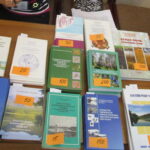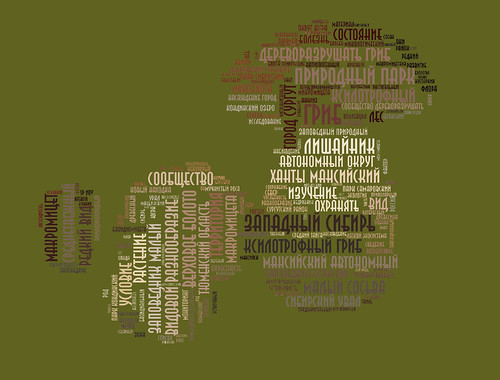Первая встреча Клуба Гриболюбов Югры прошла душевно и весело, у нас появилось желание продолжать микологические штудии в дружеском общении и развиваться в разных направлениях, например проводить регулярные семинары такого плана, а также микологические экскурсии в лес, выставки грибов и выпуск листовки Клуба.
Встреча началась с открытия экспозиции посвященной грибам расположенной в коридоре стационара. Участники познакомились с экспонатами и поговорили о планах развития выставки. Мы постараемся в скором времени сделать отдельную страницу на сайте об экспозиции, расписание ее работы и некую рекламу чтобы интересующиеся этой темой могли ее посещать.
После экскурсии была презентация об общих вопросах организации выставок грибов и разнообразии конкретных экспозиций (Pdf).
На семинаре клуба было представлено три доклада. Надежда Корнеева сделала замечательный обзор про историю и конкретные примеры деятельности натуралистических обществ в России. Аудитории был предложен материал для творческой работы:
- Прочитать и пересказать цели, задачи и конкретные мероприятия проводившиеся в рамках работы отдельных обществ (например, Московского общества испытателей природы). Это задание подсказывало разные мысли нам о том, как может развиваться работа нашего Клуба в дальнейшем.
- Выбрать наиболее подходящее название для объединения гриболюбов (название КГЮ получил спонтанно и мы решили подойти к этому вопросу более систематически совместным решением). Список синонимов см. на фотографии.
Елена Звягина подготовила интересную и красивую презентацию о редких и примечательных находках в ходе экспедиций в горы Урала. Слушатели познакомились воочию с десятком красивых грибов, обитающих в горных местностях, например: Helvella solitaria, Laccaria pumila, L. montana, L. nobilis, Sepultaria arenicola/arenosa, Lichenomphalia hudsoniana, L. alpina, Arrhenia lobata и Multiclavula vernalis. Лена рассказала о таксономических проблемах некоторых видов, экологии, местах произрастания и редкости этих находок. См. презентацию в (Pdf).
Заключительный доклад семинара был посвящен мастер-классам по крашению грибами. Евгения Андриенко описала свой опыт демонстраций окрашивания грибными красителями на четырех открытых мероприятиях. На двух из них Женя проводила уроки по окраске, т.е. непосредственно перед посетителями был окрашен образец шерсти паутинником кроваво-красным (C. sanquineus). На выставках грибов в Санкт-Петербурге и Москве Женя участвовала с образцами окрашенной шерсти (окраска была сделана Татьяной Бульонковой и немного наших образцов) и с постером про крашение. После доклада мы посмотрели замечательный фильм Mushrooms for color на английском языке, где сподвижница этого направления Miriam Rice рассказывала свою историю крашения грибами. Cм. презентацию в (Pdf).
Освящением мероприятия в медиа занимался корреспондент ГТРК «Югория» — Оксана Мороз. Первый репортаж о Гриболюбах Югры вышел на Радио Маяк: https://radiomayak.ru/shows/show/id/59986/date/29-01-2018 (Радиомост с Ханты-Мансийском с 22:10 по 28:45 мин). После этого радиослушатели должны пойти в -40 С собирать тремеллу, что замечательно и для здоровья и для познания грибов! 🙂
Наконец, мы кратко обсудили задачи КГЮ на этот год и планы ближайших встреч.
В ближайшее время (до следующей встречи в марте) нас ждут такие захватывающие занятия:
- Организация сайта КГЮ + группы ВКонтакте (https://vk.com/yugra_myco)
- Распространение журнала Планета Грибов в библиотеках Югры
- Выпуск первой листовки КГЮ
- Подготовка выставки культивируемых грибов
- Подготовка докладов на следующий семинар (темы приблизительно)
- Технология культивирования грибов (Филиппова Н.)
- Выращивание вешенки частным предпринимателем в Ханты-Мансийске (Акопян Э.)
- Культивирование Шизофиллума (Звягина Е.)
- Культивирование красильных грибов (Андриенко Е.)
До следующих встреч! которые состоятся по плану:
- 20 марта – 1 апреля – семинар «КУЛЬТИВИРОВАНИЕ ГРИБОВ»
- 20 мая – 1 июня – семинар «ГРИБНЫЕ ПЛОЩАДКИ В РАЙОНЕ ХАНТЫ-МАНСИЙСКА»
- 20 июля – 1 августа – экскурсия В ЛЕС С ОПРЕДЕЛЕНИЕМ ГРИБОВ
- 10-20 сентября – экскурсия и ФЕСТИВАЛЬ ГРИБОВ
Список участников встречи (Pdf).
ВОСПОМИНАНИЯ О ВСТРЕЧЕ:
Запомнилось все. Мероприятие, насыщенное полезной и интересной информацией + неформальная атмосфера произвело на меня чрезвычайно позитивное впечатление. Особенно хочу выделить доклад и фильм по окраске тканей (обязательно применю при случае).
Идеальный формат встречи – теплая дружеская обстановка в сочетании с научными докладами и обменом мнениями профессионалов и любителей-энтузиастов. На выставке очень понравилась бумага из грибов!
Понравилось ВСЁ! Замечательные доклады и их обсуждение. Теплая, уютная, доброжелательная атмосфера. Очень радует идея создания группы в Контакте.
О встрече гриболюбов: помимо вкусного чаепития приятно было видеть энтузиазм Нины Филипповой – когда человек любит дело, которым занимается – это заразительно действует на окружающих.
Присутствие буквально двух ученых микологов оказалось достаточным, чтобы сконцентрироваться всем участникам заседания на событиях научных, прикладных, социальных, связанных с миром грибов. Внимание не ослабевало по мере чтения докладов, обсуждений, просмотра фильма, открытия выставки. Тема грибов раскрывалась со всех сторон и наше естественное грибоедство перерастало в гриболюбство! О грибах Приполярного Урала, было настолько интересно слушать, что сразу возникали вопросы научного характера: о генетических исследованиях грибов, о проблемах видообразования, о популяционных исследованиях грибов на высокогорных плато.
И фотоальбом тоже хранит воспоминания:
Last update: 04.02.2018






















